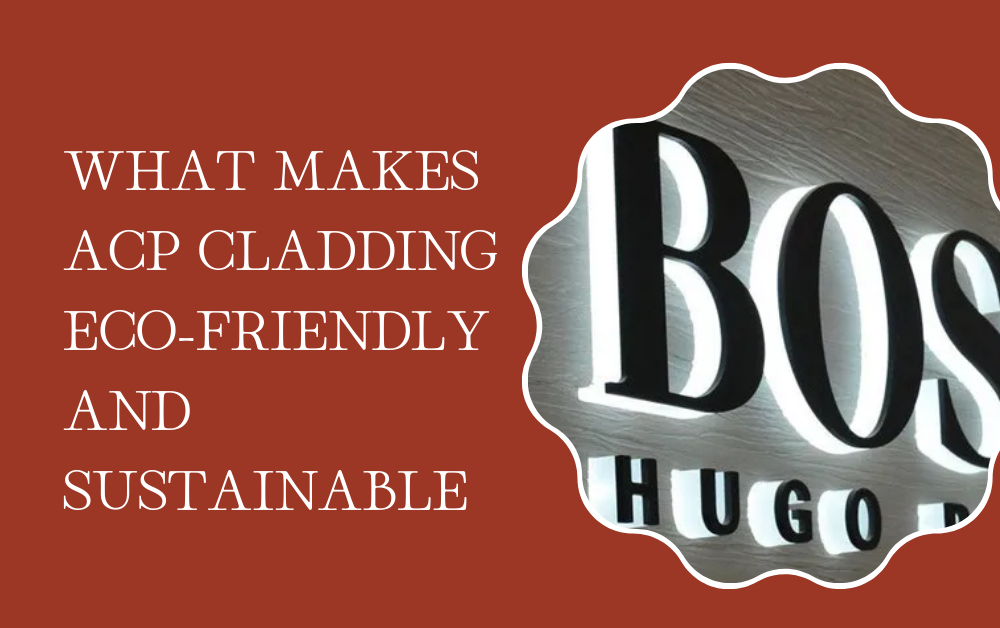Aluminum Composite Panel (ACP) cladding has become a popular choice in the construction industry. Its sleek and modern look has made it a favorite among architects and builders. But beyond its aesthetic appeal, ACP cladding offers significant environmental benefits. This blog will explore what makes ACP cladding eco-friendly and sustainable, discussing its composition, benefits, and the positive impact it has on the environment.
What is ACP Cladding?
Understanding ACP Cladding
ACP cladding consists of two thin layers of aluminum enclosing a non-aluminum core. This core can be made from different materials, such as polyethylene or mineral-filled cores. The result is a lightweight, durable, and versatile panel that can be used in various applications, from building facades to interior designs.
Composition of ACP Panels
The typical ACP panel is about 4-6mm thick. The aluminum layers are usually coated with paint or anodized to enhance durability and aesthetic appeal. The core material, often polyethylene, provides flexibility and resilience, making ACP cladding suitable for a wide range of climates and conditions.
Note:- Are you ready to make your building eco-friendly and sustainable? Discover the benefits of ACP cladding for your next project in Dubai. Enhance the aesthetic appeal and energy efficiency of your structures while contributing to a greener future. Contact us today to learn more about ACP cladding Dubai and how it can transform your building.
Environmental Benefits of ACP Cladding
Lightweight and Durable
One of the key advantages of ACP cladding is its lightweight nature. Being lighter than traditional materials like wood or steel means that less energy is required for transportation and installation. This reduction in energy use directly contributes to lower carbon emissions, making ACP cladding an environmentally friendly option.
Energy Efficiency
ACP panels have excellent thermal insulation properties. This means they help keep buildings warm in winter and cool in summer, reducing the need for artificial heating and cooling. As a result, buildings with ACP cladding consume less energy, leading to a significant reduction in greenhouse gas emissions.
Sustainable Manufacturing Processes
Recycling Aluminum
Aluminum is a highly recyclable material. The production of ACP cladding often involves recycling aluminum, which consumes only 5% of the energy required to produce new aluminum from raw materials. This recycling process significantly reduces the environmental footprint of ACP cladding, making it a sustainable choice for construction projects.
Eco-Friendly Core Materials
While the core material of ACP panels can vary, many manufacturers are now opting for eco-friendly alternatives. Mineral-filled cores, for instance, are less harmful to the environment compared to polyethylene. These sustainable core materials further enhance the eco-friendliness of ACP cladding.
Long Lifespan and Low Maintenance
Durability and Longevity

ACP cladding is known for its durability and long lifespan. Unlike traditional materials that may degrade over time, ACP panels resist weathering, corrosion, and other forms of wear and tear. This longevity means fewer replacements and repairs, reducing the overall environmental impact of building maintenance.
Low Maintenance Requirements
Another significant benefit of ACP cladding is its low maintenance needs. The panels are easy to clean and maintain, requiring minimal use of cleaning agents and other chemicals. This low maintenance aspect not only saves resources but also reduces the environmental impact associated with the use of cleaning products.
Fire Safety and Environmental Impact
Fire-Resistant Properties
Many ACP panels are Shop Signage with fire-resistant properties. The use of fire-retardant materials in the core enhances safety and reduces the risk of fire-related damage. This fire resistance not only protects buildings and occupants but also minimizes the environmental damage caused by fires.
Reducing Pollution
The production and use of ACP cladding contribute to reducing pollution. The panels’ lightweight nature means that fewer vehicles are needed for transportation, leading to lower emissions. Additionally, the reduced need for heating and cooling in buildings with ACP cladding helps cut down on air pollution from power plants.
Design Flexibility and Aesthetic Appeal
Versatile Design Options
ACP cladding offers a wide range of design options. The panels can be customized in various colors, finishes, and textures, allowing architects to achieve their desired aesthetic. This design flexibility not only enhances the visual appeal of buildings but also encourages the use of sustainable materials in innovative ways.
Modern and Sleek Appearance
The modern and sleek appearance of ACP cladding makes it a preferred choice for contemporary architecture. Its ability to mimic other materials, such as wood or stone, without the associated environmental drawbacks, further emphasizes its sustainability.
Cost-Effectiveness and Value
Affordable and Efficient
ACP cladding is cost-effective compared to many traditional building materials. Its affordability, combined with the benefits of durability and low maintenance, provides excellent value for money. This cost-effectiveness makes it accessible for a wider range of projects, promoting the use of eco-friendly materials in construction.
Long-Term Savings
The energy efficiency and low maintenance requirements of ACP cladding lead to long-term savings. Building owners can save on energy bills and maintenance costs, making ACP cladding a financially sustainable choice. These savings also contribute to the overall environmental benefits by reducing resource consumption.
Promoting Sustainable Construction Practices
Supporting Green Building Standards
The use of ACP cladding aligns with various green building standards and certifications. By incorporating ACP panels into their designs, architects and builders can achieve higher ratings for sustainability and energy efficiency. This alignment with green building standards encourages the adoption of environmentally friendly practices in the construction industry.
Encouraging Responsible Sourcing
Many ACP manufacturers are committed to responsible sourcing of materials. This commitment includes using recycled aluminum, eco-friendly core materials, and sustainable production processes. By choosing ACP cladding, builders support these responsible sourcing practices, contributing to a more sustainable construction industry.
Conclusion
ACP cladding stands out as an eco-friendly and sustainable option in modern construction. Its lightweight and durable nature, energy efficiency, and use of recyclable materials make it a preferred choice for environmentally conscious builders. The long lifespan, low maintenance requirements, and fire-resistant properties further enhance its sustainability credentials. By promoting the use of ACP cladding, we can support sustainable construction practices and contribute to a greener future.
Read more informative blog at findtec.







